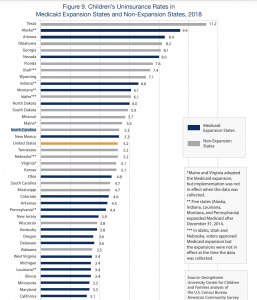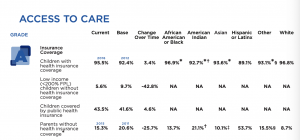Hi, my name is Miranda Layne, and I am a student at UNC-Chapel Hill. My presentation focuses on what major factors lead to a lack of insured children in North Carolina compared to other states along with the disparities seen among those who are not insured. For years, the nation has been on a positive trajectory trying to reduce the number of children uninsured and while their tactics seem to have been working, lately data show that the progress is vulnerable. My initial assumptions about the coverage of children within healthcare in NC contradicts this finding, so it intrigued me to keep researching the data surround this topic. Making sure children are insured is important because not only are they more likely to need services, but they also rely on their elders in many ways. Therefore, providing increased awareness of the importance to insure children will help their families out immensely as well. Within this presentation I want to focus on the main reasons that NC healthcare access is lacking such as: lack of Medicaid expansion, overall lack of access, and lack of awareness and negative preconceptions; and I also want to bring to attention the solutions that are beginning to be implemented.
“While children’s health coverage rates have been improving for many years prior to 2014, the Affordable Care Act pushed those rates to their lowest in 2016” (Alker & Roygardner, 2019, p.2). However, these trends have reversed course, as 400,000 more children are uninsured in the United States from 2016-2018 alone. Alker and Roygardner (2019) explains that the coverage losses are widespread within 15 states, North Carolina being one of them. North Carolina had an increase of 15,000 uninsured children from the years 2016 to 2018, that is a 13.0% increase. One of the main factors that has led to this trend is the lack of Medicaid coverage expansion within the state. States, such as North Carolina that are maintaining a lack of access to affordable care are falling further behind due to their lack of expanded Medicaid. In the chart below from Alker and Roygardner (2019), you can see that the uninsurance rate in Medicaid non-expansion in North Carolina is even higher than that of the United States as a whole.

Chart from Alker & Roygardner (2019) looking into the rate of unisured children due to Medicaid non-expansion (Alker & Roygardner, 2019, p.11).
Besides Medicaid non-expansion being a major factor for the increase in uninsurance rates, another factor is the overall lack of access to healthcare in some areas of North Carolina. The 2018 North Carolina Child Health Report Card focuses on this lack of access and details the problems that surround this unfortunate situation. The article mentions that “the percent of low-income children (5.6%) continue to decline, falling 43% percent in NC between 2012 and 2016” (2018, p.7). Not only does NC show disparities as a whole compared to other states, but there are also disparities to be seen within NC pertaining to those that are uninsured and lack access to affordable healthcare. In North Carolina, “Hispanic and American Indian parents are less likely to have health insurance coverage than other races” (2018, p.7). This brings to the forefront other determinants and factors that determine a family’s access to healthcare. For some races, they not only have to worry about their income or what district they live in, but they also have to worry about being judged on their race and those judgements in turn affecting their eligibility for affordable, preventative healthcare. The chart below from the Report Card details the disparities using specific statistics which makes the patterns more noticeable.

Chart from 2018 NC Child Health Report Card detailing the disparity in race seen within races pertaining to the access to affordable healthcare for children and families (2018, p.6).
A study done through UNC-Chapel Hill from the American Journal of Infection Control provides evidence of the difference in accessibility to vaccines and other healthcare opportunities. The article points out that “vaccination is of particular importance for under- and uninsured children, more so than school-aged children with private insurance. Because these students are from poor families without access to private insurance, they may lack many of the family and financial safety nets of their peers. Short, acute illnesses that can be shrugged off with a visit to the pediatrician’s office and parents takinga few days off from work for relatively affluent children will be more problematic for the vulnerable population in our study” (Trogdon & Ahn, 2015, pg. 235). This quote brings to the forefront how crucial a simple vaccine is to those without proper sanitation in their homes and lack of access to a doctor for their children compared to those in nice neighborhoods and clean, funded school districts. Within the study, it was found that there was a correlation between the number of vaccines given in an area and the ZIP code tabulation area level. “ZCTAs tended to have influenza vaccination rates that were similar to their neighborhoods” (Trogdon & Ahn, 2015, p. 234). This phenomenon is also something we are discussing in my health and disease ecology class relating to COVID-19. There seems to be many more vaccination clinics around areas that are more populated and more funded while in reality, there needs to be more clinics in the areas that are not funded as much and don’t have the means to live in a sanitized, COVID safe environment. This article does a great job at providing a real-world evidence example of the discrepancies seen in access to healthcare for children and families in NC.
While there are still many children that lack equal access to healthcare in North Carolina, the Affordable Care Act has narrowed the racial and ethnic gap a bit. “Disparities have narrowed in both states that have expanded Medicaid eligibility and those that did not” (Baumgartner et al., 2020, para.7). For instance, “the gap between black and white adult uninsured rates dropped by 4.1 percentage points, while the difference between Hispanic and white uninsured rates fell 9.4 points” (Baumgartner et al., 2020, para.6). This decrease in the gap between races eligible for Medicaid is a step in the right direction, but there are still other steps that need to be taken in order to help those that are unsure of their next steps, or those that are unsure if they are even eligible. As an article by Kenney et al. points out, “prior research found that although participation increased, variation in participation across states and subgroups persisted even when controlling for differences in the composition of eligible children across states” (Kenney et al., 2015, p.S36). The reasons for these differences seem to be a “lack of awareness of the programs or of eligibility, difficulties with application processes, uncertainty about where to obtain information, cost concerns; and for some families, a lack of interest in enrolling” (Kenney et al., 2015, p.S36). Lots of low-income families with uninsured children have reported negative perceptions with processes of enrollment and the overall healthcare program. In order to start helping the millions of children and families that remain uninsured, there needs to be programs that help low-income, or even higher-income families understand the benefits and enrollment processes of healthcare and what plans may fit best for them. Having millions of people that do not want to enroll based on preconceived, negative notions should be considered unacceptable to the states and workers whose jobs it is to help families enhance their quality of life and health.
Overall, while there has been some action towards equal access to healthcare for all children and families, it is clear that there needs to be more awareness towards not only the programs available but also the lack of access within NC. Even though I have lived in NC my whole life I was unaware of how many lack access to healthcare, especially children. While there are many ads and billboards that seem to advocate for healthcare in the interstates, there needs to be a reality check of how many people already have negative preconceptions of healthcare that will not change just because a billboard with a smiling face told them to apply. It is becoming increasingly important for children to have access to healthcare because children depend on their parents for longer period of time than they ever have before. Children are more likely to need services and healthcare can help provide better health for these children and their families, especially if they are low-income. In the near future, there needs to be greater access to programs that detail the positive aspects of healthcare as well as increased expansion of Medicaid eligibility that way the families that truly need the service can apply for it.
References list:
Alker, J., & Roygardner, L. (2019, October). The number of uninsured children is on the rise. https://ccf.georgetown.edu/wp-content/uploads/2019/10/Uninsured-Kids-Report.pdf
Baumgartner, et al. (2020, January). How the Affordable Care Act has narrowed racial and ethnic disparities in access to health care. The Commonwealth Fund. https://www.commonwealthfund.org/publications/2020/jan/how-ACA-narrowed-racial-ethnic-disparities-access
North Carolina child health report card 2018. (2018, February). NC Child. https://ncchild.org/wp-content/uploads/2018/02/2018-CHRC-FINAL.pdf
Trogdon, J. G., & Ahn, T. (2015). Geospatial patterns in influenza vaccination: Evidence from uninsured and publicly insured children in North Carolina. American Journal of Infection Control, 43(3), 234–240. https://doi.org/10.1016/j.ajic.2014.11.022
Featured Image:
Facebook. Retrieved April 1, 2021, from https://www.facebook.com/login/?next=https%3A%2F%2Fwww.facebook.com%2FHealthCareForAllNC%2F